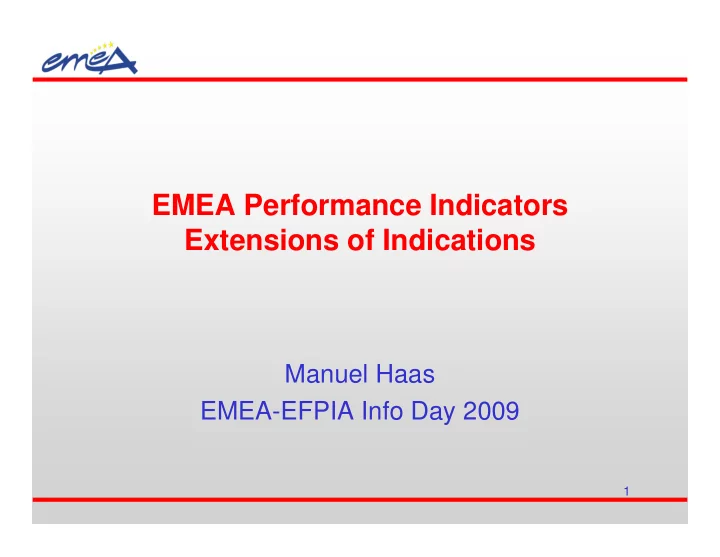

EMEA Performance Indicators Extensions of Indications Manuel Haas EMEA-EFPIA Info Day 2009 1
Contents • Methods • Procedures – Overview – Requests for supplementary information & Major objections – Review times – Scientific Advisory Groups & ad-hoc expert groups – Outcome • Questionnaires – Outcomes & relation with procedures outcome /assessment • Conclusions 2
Methods • Study periods: EFPIA Info Day 2009: 01/01/2007 – 31/12/2008 EFPIA Info Day 2007: 01/06/2005 – 31/09/2006 • Includes: All extension of indication procedures with outcome in study period (positive, negative, withdrawal) • Excludes: Double-applications 3
Overview Jun.05-Sep.06 2007-2008 (16 months) (24 months) Sample 39 85 EMEA SA 8 (21%) 13 (15%) MO 14 (36%) 46 (54%) OE 3 (8%) 10 (12%) SAGs/ 1 (3%) 8 (9%) ad-hoc expert groups 4
Requests for Supplementary Information and Major Objections 64% 59% 54% 52% 46% 36% 35% 28% 12% 8% 3% 3% Jun 05-Sep 06 2007-2008 Jun 05-Sep 06 2007-2008 0 RSI 1 RSI 2 RSI >2 RSI MO: Yes MO: No 5
Median Review Times 250 223 216 200 188 158 152 150 148 100 78 64 50 37 0 Jun 05 - Sep 06 2007 2008 Overall Clock-stop Active 6
Median clock-stop times with & without MO 90 80 84 80 70 67 60 50 44 40 30 27 28 20 10 0 Jun 05 - Sep 06 2007 2008 MO: Yes MO: No 7
Scientific Advisory Groups & ad-hoc expert groups SAG SAG SAG SAG Ad-hoc Cardiovascular Anti-inf. Diabetes/End. Oncology expert group Total Jun.05-Sep.06 0 1 0 0 0 1 2007-2008 1 1 3* 2 1 8 Total 3 2 1 1 2 9 * 3 SAGs for 2 procedures SAGs / ad-hoc expert groups typically convened to assess the clinical relevance of data to the population applied for, or adequate sub-populations in the context of a concern relating to safety, methodology or effect size/consistency. 8
Scientific Advisory Groups & ad-hoc expert groups • Of the 8 procedures with SAG / ad-hoc expert group: – 4 resulted in a new indication – 4 resulted in a negative opinion or a withdrawal • Procedure outcome always consistent (except in one instance) with SAG recommendations in this sample 9
Procedure Outcomes 90% 83% 10% 7% 6% 4% Jun. 2005-Sep. 2006 (N=39) 2007-2008 (N=85) Positive (4.1) Positive (other than 4.1) Withdrawn Negative 10
ATC Distribution: new indications vs. initial CAPs 39% 26% 21% 20% 19% 15% 11% 10% 8% 8% 8% 8% A B J L N Other Distribution of initial CAPs as of 2008 Distribution of Ext. of indications granted in 2007-2008 A = Alimentary tract and metabolism; B = Blood and blood forming organs; J = Anti-infective for systemic use; L = Antineoplastic and immuno-modulating agents; N = Nervous system 11
Questionnaires Question 1: Was the dossier presented in a satisfactory way (layout, organisation of data, etc)? Question 2 : Were all important data/analysis included in the dossier thereby making benefit risk assessment easy? Question 3: Was the “scientific overview” (expert report) sufficiently critical? Percentage of procedures with (Co-)Rapporteurs’ response: 62% (72% in 2005-06) 12
Questionnaires: outcome (means) • Q1=6.9 • Q2=6.6 • Q3=6.1 • Global=6.6 Slightly better scores than in 2005-06 13
Questionnaires • No clear relation between Question 2 score ( � 5 or >5) and Major Objections (Yes/No) (Calculated � 2 value = 0.03 < tabled � 2 value (3.84), � = 0.05) • No clear relation between Question 2 score ( � 5 or >5) and outcome (new indication or not) ( Calculated � 2 value = 1.20 < tabled � 2 value (3.84), � = 0.05 ) 14
Conclusions • Higher volume of procedures in 2007-08 compared to 2005-06. • Longer review times in 2007-08 compared to 2005-06, with longest times in 2007. • Stabilisation of review times in 2008, in particular due to decreasing clock-stops for procedures without MO. • More procedures led to MO and required extra CHMP expertise (SAGs) than in 2005-06. Procedure outcomes consistent with SAG recommendations. • High rate of success (i.e. granting of a new indication), although slightly inferior to that of 2005-06. • Good level of Rapporteurs’ satisfaction with dossier presentation/content. However, no clear relation with procedure outcome/complexity. 15
Recommend
More recommend